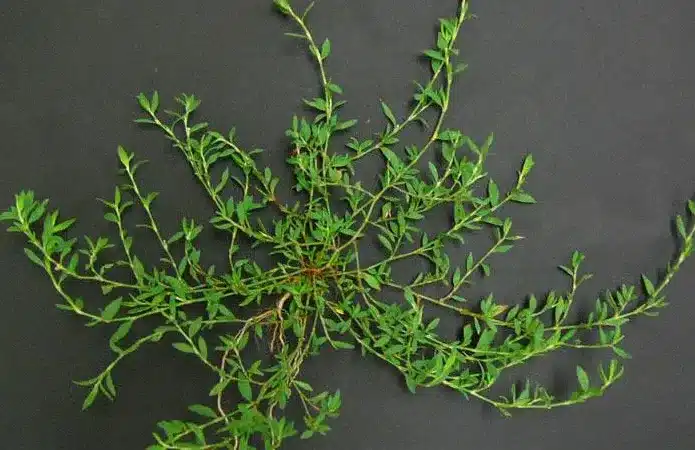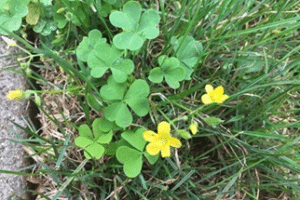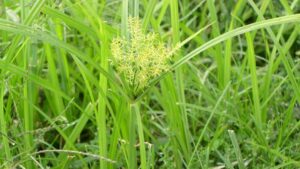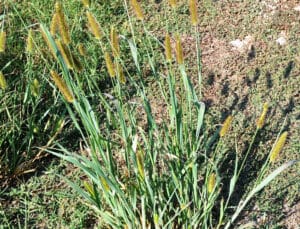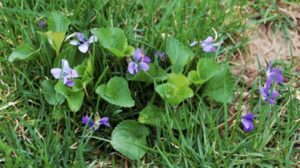Description
Common knotweed or equal-leaved knotgrass, Polygonum arenastrum, is also known as wiregrass, wireweed, matweed or doorweed. It is an annual species that is native to Europe that has established itself throughout most of the United States and Canada. It is found in field crops, row crops, orchards, yards, gardens and turf. It is tolerant of soils compacted by trampling with foot traffic and is therefore frequently found along paths and walkways. This weed is particularly well adapted to the winter and early spring rainfall pattern throughout California. It gets a good start with the early moisture and establishes a taproot, which allows it to survive the summer drought.
Life Cycle
Common knotweed germinates in late winter or early spring, when sufficient moisture is available. It often germinates in soil cracks in compacted soil. Though it germinates in early spring, it grows slowly and upright before becoming prostrate. If mowed, it remains prostrate and spreads. It can form mats 3 to 4 feet in diameter. Seeds develop on the plant low to the ground and seedlings readily survive mowing. Like other species in the genus Polygonum, seed in the soil are probably long-lived. Flowering may occur from March through October.
Cultural Control
One of the most important management methods is to prevent soil compaction, which provides the conditions under which this weed grows best. Arrange landscapes so that soil is less likely to become compacted. Spread out foot and vehicle traffic over a broader area. Use fences or hedges to reduce traffic and install rock or pavement pathways where traffic cannot be avoided. Do not trample areas soon after irrigation or rainfall. Arrange soccer fields and athletic areas so that heavily used areas such as goals, midfields, and sidelines can be rotated.
Aeration
Loosening the soil in lawns to provide better drainage and a better environment for more desirable species can be beneficial. If areas are compacted, loosen the soil and overseed with a locally adapted grass seed.
Mulches
A variety of mulches can be applied to planting beds and other landscaped areas to prevent establishment of common knotweed. Mulching with landscape fabrics can be effective if the fabric is overlapped and no light is allowed to penetrate to the soil. Use a polypropylene or polyester fabric or black polyethylene (plastic tarp) to block all plant growth. Rock or organic mulches such as bark or compost can be used over the top of synthetic fabrics. If used alone, organic mulches should be 3 to 4 inches thick. Finer mulch material is not desirable since weeds seed may easily grow in it. Coarser material will drain readily and reduce seedling establishment of common knotweed. Mulch needs to be replenished each year to maintain cover thickness and eliminate light penetration to the soil.
Prevent knotweed from producing seed by controlling young plants. This will reduce the amount of seed present in the soil in succeeding years.
Cultivation
Common knotweed is easy to remove with common weeding tools, such as a swivel hoe. For the home gardener, frequent manual removal along with mulching should be sufficient to manage this weed in most situations.
Herbicides
There are many herbicides that will control common knotweed, but they are not generally required in home garden situations. The selection of the herbicide is governed by the site and, should there be one, the crop. Remember that many of these herbicides can have negative effects on desirable plants as well and should be used with care, especially in a landscape situation.
Preemergent herbicides must be applied before the knotweed seed germinates. Examples of preemergent herbicides available for home use include products containing benefin, dithiopyr, oryzalin, pendimethalin, prodiamine, and trifluralin.
The following additional preemergent herbicides are only available to licensed pest control operators: atrazine, hexazinone, napropamide, oxadiazon, pronamide, and simazine.
Postemergent herbicides like those containing dicamba (for use in turfgrass only), glyphosate, and pelargonic acid will control emerged common knotweed. For best results, these herbicides must be used while the weed is young, preferably the early seedling stage, before it becomes more established and hardened off. When knotweed is young (i.e., less than 3 inches in diameter), it can be controlled with 2,4-D, and there are a number of products available for home use that contain this chemical. Some postemergent herbicides kill the top growth of a plant, but it may regrow from buds on the crown of the plant.

